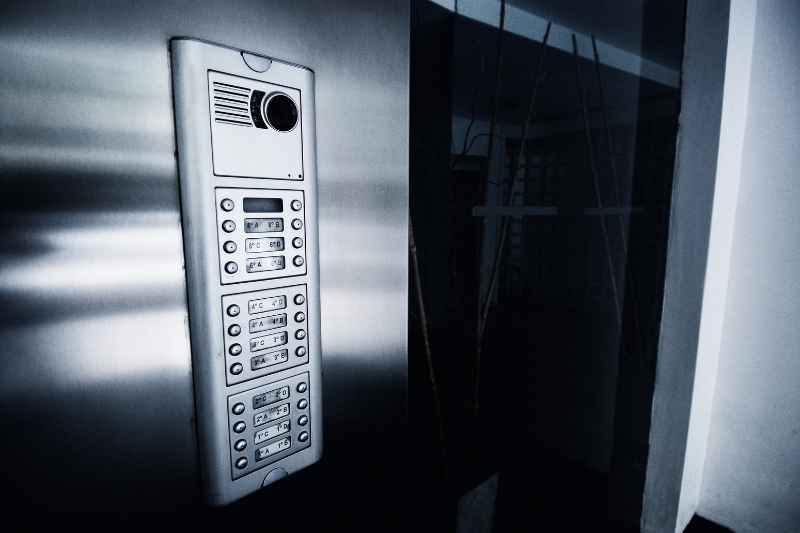Key takeaways
- 2-wire door intercom systems use wires to connect master stations to base stations so that a visitor at a master station can request entry from a resident using a base station.
- While original 2-wire intercom systems only had audio capabilities, today’s intercoms can use the same wiring to transport video and grant you access to other features.
- If you’re interested in replacing a wired intercom system, manufacturers have made it easy to replace old master and base stations with new ones.

The intercom system at your front door is an important piece of hardware that helps you welcome guests onto your property. Many intercoms in buildings today are 2-wire intercom systems. But how do they work under the hood, and what should you do if you need an upgrade?
First, we explain what a 2-wire intercom system is and how it works. Then, we explore the differences between 2- and 4-wire intercoms. Finally, we explain how you can replace a wired intercom system.
This post covers:
- What is a 2-wire intercom system?
- What is the difference between 2- and 4-wire intercoms?
- How does a 2-wire intercom system work?
- Replacing a 2-wire intercom system
What is a 2-wire intercom system?
2-wire intercom systems are intercoms that use two wires to establish communications with different pieces of intercom hardware across the building. One wire is responsible for audio and video signals, while the other wire is responsible for power.
2-wire intercom systems have these components:
- Master station. The master station is installed at your property’s entryway. It contains a directory that guests use to choose the resident they’d like to speak to.
- Base station. Base stations are installed in every resident’s unit. Residents use base stations to converse with guests and grant them entry.
- Door release. If the resident wants to grant their visitor entry, they press a button on their base station that sends a signal to the door release at your property’s front door. This disengages the front door lock for a small window of time and allows the guest to enter.
Watch how ButterflyMX works:
What is the difference between 2- and 4-wire intercoms?
While researching 2-wire intercoms, you’ve probably encountered the term 4-wire intercom. But what does this mean, and what are some differences between the two?
In a 4-wire intercom system, two wires are connected to the power supply, and two signal wires are connected to the programmable logic controller or PLC. Conversely, in a 2-wire intercom system, one wire is connected to the power supply, and one is connected to the PLC.
Because of these extra wires, in a 4-wire communication system, the paths are different for transmitting and receiving messages. In simpler terms, one wire allows you to talk, while the other allows you to listen. So, residents and guests can speak at the same time.
Differences between 2- and 4-wire intercom systems:
How many wires are needed for an intercom system?
So, you know the difference between 2- and 4-wire intercom systems, but exactly how many wires does an intercom system need?
The answer varies.
It depends on how old your intercom system is and whether or not it’s been retrofitted. In fact, the number of wires can be as little as two, which we’ll explore more in the next section, but as many as eight.

How does a 2-wire intercom system work?
A 2-wire intercom system works by transmitting audio back and forth between a master station and a base station.
Two-wire intercoms allow residents to let somebody at the front door in. But many come with one significant limitation: When the resident is speaking to their guest, both parties can’t talk at the same time. This is because of the way wired intercom systems are designed.
These intercoms depend on copper wiring, the same technology that old-school intercom system wire telephones use. And because only one wire handles audio, you can only carry audio in one direction at a time. You may have used an analog apartment buzzer system. In that case, you need to press a button to talk and release it to allow the other person to talk.
If you want to enable simultaneous communication with a wired system, you’d need to install a 4-wire intercom.
These days, intercoms are much more powerful than their humble copper-wire beginnings. As telephone and telecommunications tech evolved, so did the intercom.
For example:
- More modern wired intercom systems use the same wires that computers use to talk to each other.
- So, 2-wire IP intercoms take advantage of the internet to transmit more data, giving residents access to more features.
2-wire intercoms in the 21st century
Modern intercoms use the same two-wire structure to carry more information and perform sophisticated tasks.
For example, modern 2-wire video intercom systems come with monitors and cameras that allow residents to see a live feed of the person requesting access.
You can also connect these intercoms to the cloud. As a result, you can manage them and update permissions from any device — even if you’re not on the property.
Replacing an intercom 2-wire system
If you’re interested in replacing your old 2-wire intercom system, you’re in luck. Many of today’s access control providers know that most 2-wire intercoms were installed in the age of copper wiring and old telephone technology.
In response, they’ve developed wired intercom kits which make retrofitting your old intercom system easy by working with existing wiring.
Keep in mind: While working with existing wiring is a great temporary solution, it has its drawbacks.
So, what do you do when that wiring itself fails? Over decades of use, copper eventually degrades.
The best intercoms answer that question by removing all of your dependency on old wiring.

The best 2-wire intercom system replacement
Take ButterflyMX’s mobile access intercom as an example. Instead of installing wire-dependent base stations outside of every unit, our access control system allows your residents to use their smartphones as base stations.
Residents can swipe to open the door using their smartphones — and that’s only one feature out of many they can use with our app.
While residents enjoy increased convenience, you benefit because you no longer have to worry about maintaining wiring or in-unit base stations — all you have to install is the ButterflyMX master station. Your residents’ phones will do the rest of the work.

